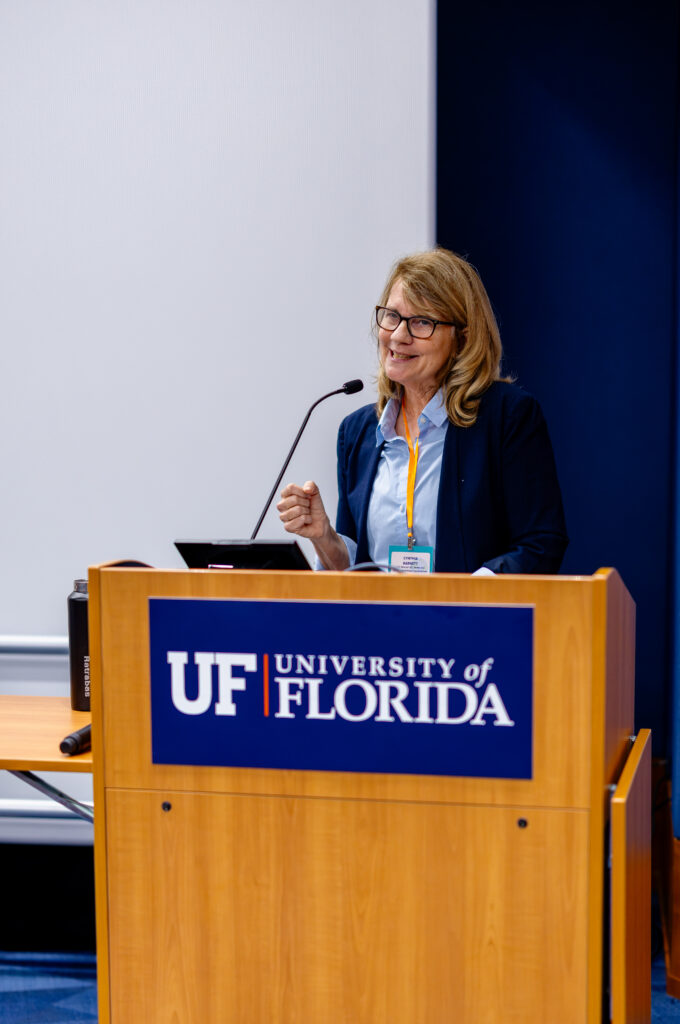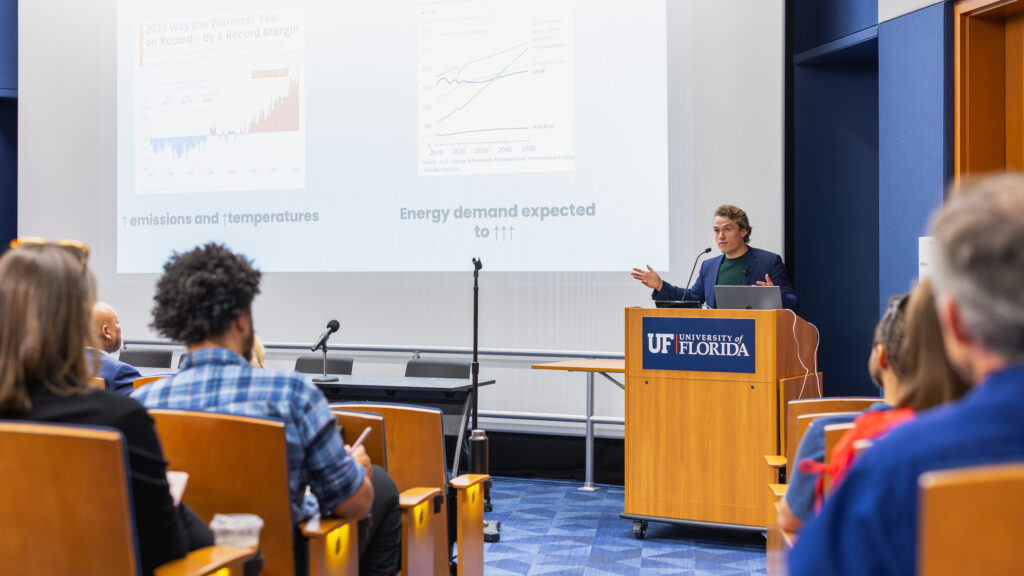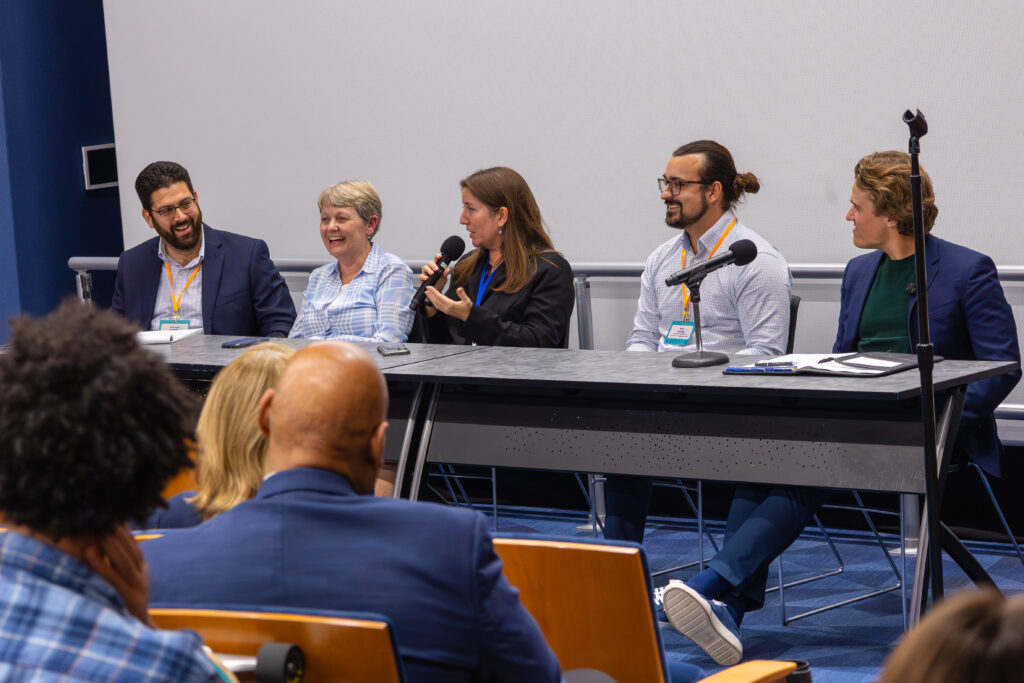By Bailey Daigle
The way we tell the climate story has the power to transform a feeling of collective overwhelm into one of collective empowerment.
The University of Florida’s 10th annual Climate Communications Summit brought together students, journalists, community stakeholders and industry professionals to explore how thoughtful language can inspire increased environmental action and lead to more localized solutions.
Summit panelists shared insights on how local environmental reporting with a focus on human-centered storytelling can serve as a model for inspiring the change needed within larger systems.
Understanding the climate situation

Our climate demands attention as the world navigates the conflicting challenge of both rising emissions and increasing demand for energy. Recently, there has been an uptick in extreme weather events, with hurricanes battering inland cities like Asheville, North Carolina, and snow blanketing beaches in Pensacola, Florida.
Last year was the warmest year on record, with atmospheric carbon dioxide levels rising from approximately 278 parts per million during pre-industrial times to about 420 parts per million today, according to NASA.
The challenge is more than just the rising numbers – the real work lies in turning awareness into action.
“Climate change is one of the major stories of our time. We want to give students and professional journalists increasingly better tools as we learn how to talk about the story in ways that are human-centered, precise and accurate,” said Cynthia Barnett, organizer of the summit and the director of Climate and Environment Reporting Initiatives at UF’s College of Journalism and Communications.
Centering climate conversations around personal connections to the environment helps shift the focus from political divides to a shared value of preserving the planet we all call home.
These sentiments were the driving force behind UF’s Climate Communications Summit. Through workshops, presentations and candid conversations, the event equipped attendees with the tools to help shift the climate narrative from one that fuels panic to a story that inspires hopeful action.
Making nature a nonpartisan issue
As numbers continue translating into real-world consequences, 53% of people worldwide report being more worried about climate change now than last year. However, as climate change concerns grow in the U.S., so does political division over the issue.
Keynote speaker Benji Backer, founder of the American Conservation Coalition and author of “The Conservative Environmentalist,” explained that how we talk about our climate has contributed to deepening partisan divides.
He pointed out that terms like “environmentalist” have shifted from reflecting a general concern for the planet to a more politically charged label.

In 1989, 76% of Americans considered themselves environmentalists. By 2021, that majority declined to 41%.
Backer’s nationwide initiative, Nature is Nonpartisan, seeks to reimagine the environmental movement by shifting the focus from politics to shared responsibility.
He believes that while we all have different “whys” for environmental action, real change can happen when we find common ground in our shared appreciation of the earth.
“The environment is something we all share and something we used to fight for together,” Backer said, “and now parties too often fight with each other instead of coming together.”
The political divide on climate often stems from the misconception that one side’s gain means the other’s loss. Yet, many countries, including the U.S., have experienced the way that investments in clean energy and sustainable industries can drive economic growth. In 2023, U.S. clean energy jobs grew more than double the rate of the overall labor market, creating 149,000 new jobs.
Driving global change through local solutions
Florida faces more immediate and widespread environmental risks than many other states, making it a powerful launchpad for progress. With 90% of Floridians acknowledging climate change, compared to the 74% national average, the state is more acutely aware of the threats.

“Florida is the epicenter of what it takes to build nonpartisan environmental action,” Backer said.
He believes that Florida’s social and ecological landscape supports a wide variety of residents to prioritize conservation.
Max Chesnes, a UF journalism alumnus who covers climate and environment at the Tampa Bay Times, highlighted a recent bipartisan example of Floridians coming together to fight for environmental preservation. He shared insights from when he broke the story about a proposal to replace natural spaces with golf courses, hotels and other amenities at nine Florida state parks, including Jonathan Dickinson State Park.
From social media to statewide protests, Chesnes described how the movement “took on a life of its own,” and within just eight days, public outcry led to the shelving of a plan that had likely been in the works for at least a year before it became public.
When people feel a deep personal connection to their environment, protecting it becomes second nature — an instinctual defense of home.
Inspiring agency with intentional language
While personal connection to the environment sparks concern, giving people agency can transform concern into action.
According to Chesnes, the most common question he receives after publishing a story is, “How can I help?”
Summit panelists stressed that while climate stories should raise awareness, they must find ways to empower audiences toward meaningful action. They warned that fear-based narratives, which frame the crisis as inevitable or hopeless, often paralyze people or leave them overwhelmed with guilt rather than motivating change.
Benji Backer compared the climate crisis to facing a daunting to-do list with 30 tasks — it’s hard to know where to start. Meaningful progress can be made when individuals view any small contribution as checkmarks on our shared to-do list for a sustainable future.
To move from awareness to impact, panelists gave many clear ways that everyday actions can help drive climate solutions:
- Spark climate conversations with curiosity: Share your passion for climate issues with friends, family and colleagues, and ask open-ended questions to promote understanding.
- Engage locally: Find ways to support the environment through actions you enjoy, such as volunteering at a local farm or attending climate events.
- Diversify news sources: Broaden your intake of information to gain a well-rounded view of issues and take time to understand the context behind the coverage.
- Communicate with clarity: Move beyond fear-based messaging by giving people ways to help and using visuals to make complex ideas more relatable.
- Amplify local stories: Support and share regional journalism that highlights solutions and community voices.
- Protect your mental well-being: Recognize it is common to feel overwhelmed and know when to step back and recharge.
Events like this year’s summit remind us that climate solutions start with the way we share stories and relate to each other. The right words can turn division into dialogue, concern into action and local efforts into global change.
This piece was originally published by the Thompson Earth Systems Institute at https://www.floridamuseum.ufl.edu/earth-systems/blog/tell-me-about-communicating-about-our-climate/. Banner photo: Another image of Backer at the summit (Photo by Jenna Ayoub/UF College of Journalism and Communications).
Sign up for The Invading Sea newsletter by visiting here. To support The Invading Sea, click here to make a donation. If you are interested in submitting an opinion piece to The Invading Sea, email Editor Nathan Crabbe at ncrabbe@fau.edu.



